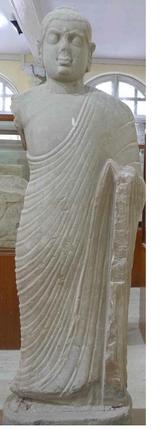B. KOLAPPAN
“The ninety-feet high marble-encased cupola, surmounted by big stone umbrellas, the series of tall slender marble columns on the platforms marking four cardinal points, the four festooned gateways flanked by lion-topped columns and the fourteen-feet high sculptured railing round the stupa, all of which together must have been a sight of glory,” it adds.
The last reference identifying it as a Buddhist learning centre is found in the writings of Sri Lankan Buddhist monk Dharmakeerti. He talks about the presence of a two-storeyed building and a giant size Buddha. The place was known as Mahaceitiya (Great Ceitiya), where the relics of Buddha were kept.
“It fell into ruins, and when Col Colin Mackenzie, the first Surveyor General of India visited the place in 1797, it was a mound of sculptures and artefacts. The first excavation was done by Sir Walter Elliot in 1845 and he collected what is known as the Amaravati Marbles,” said noted archaeologist R. Nagaswamy, who was also the Director of the Archaeology Department.
Some of the sculptures and artefacts were brought to Chennai for exhibition and some to Calcutta and finally to the British Muesum.
By the time Robert Sewell, an expert on Vijayanagar Empire, arrived at the scene, the Buddhist stupa had already been destroyed.
“There is also a report how a local Jamindar had burnt these sculptures and other invaluable to make lime for his building,” explained Mr. Nagaswamy.
It was Edward Green Balfour, the first officer-in-charge of the Museum in Chennai, brought first set of marble slabs for display while sending some to England. Subsequently, Dr George Bidie exhibited them in their present location in the museum.
“One garland motives represent the relics of Buddha being carried in eight different directions,” Mr Nagaswamy said, adding Amara Rama, an ancient Hindu pilgrim centre was also present nearby.
A note by the Chennai Museum, where there is a separate section for Amaravati sculptures, describes the Amaravati Stupa as poetry in marble
[link]

